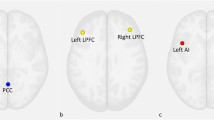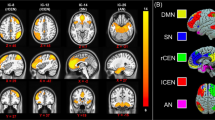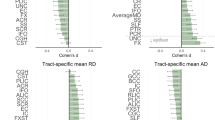Abstract
The high comorbidity among neuropsychiatric disorders suggests a possible common neurobiological phenotype. Resting-state regional cerebral blood flow (CBF) can be measured noninvasively with magnetic resonance imaging (MRI) and abnormalities in regional CBF are present in many neuropsychiatric disorders. Regional CBF may also provide a useful biological marker across different types of psychopathology. To investigate CBF changes common across psychiatric disorders, we capitalized upon a sample of 1042 youths (ages 11–23 years) who completed cross-sectional imaging as part of the Philadelphia Neurodevelopmental Cohort. CBF at rest was quantified on a voxelwise basis using arterial spin labeled perfusion MRI at 3T. A dimensional measure of psychopathology was constructed using a bifactor model of item-level data from a psychiatric screening interview, which delineated four factors (fear, anxious-misery, psychosis and behavioral symptoms) plus a general factor: overall psychopathology. Overall psychopathology was associated with elevated perfusion in several regions including the right dorsal anterior cingulate cortex (ACC) and left rostral ACC. Furthermore, several clusters were associated with specific dimensions of psychopathology. Psychosis symptoms were related to reduced perfusion in the left frontal operculum and insula, whereas fear symptoms were associated with less perfusion in the right occipital/fusiform gyrus and left subgenual ACC. Follow-up functional connectivity analyses using resting-state functional MRI collected in the same participants revealed that overall psychopathology was associated with decreased connectivity between the dorsal ACC and bilateral caudate. Together, the results of this study demonstrate common and dissociable CBF abnormalities across neuropsychiatric disorders in youth.
This is a preview of subscription content, access via your institution
Access options
Subscribe to this journal
Receive 12 print issues and online access
$259.00 per year
only $21.58 per issue
Buy this article
- Purchase on Springer Link
- Instant access to full article PDF
Prices may be subject to local taxes which are calculated during checkout




Similar content being viewed by others

References
Kessler RC, Chiu WT, Demler O, Walters EE. Prevalence, severity, and comorbidity of 12-month DSM-IV disorders in the national comorbidity survey replication. Arch Gen Psychiatry 2005; 62: 617–627.
Flamez B, Sheperis C. Diagnosing and Treating Children and Adolescents: A Guide for Mental Health Professionals. John Wiley and Son's: New Jersey, 2016.
Angold A, Costello EJ, Erkanli A. Comorbidity. J Child Psychol Psychiatry 1999; 40: 57–87.
Etkin A, Wager TD. Functional neuroimaging of anxiety: a meta-analysis of emotional processing in PTSD, social anxiety disorder, and specific phobia. Am J Psychiatry 2007; 164: 1476–1488.
Ellison-Wright I, Bullmore E. Anatomy of bipolar disorder and schizophrenia: a meta-analysis. Schizophr Res 2010; 117: 1–12.
Menon V. Large-scale brain networks and psychopathology: a unifying triple network model. Trends Cogn Sci 2011; 15: 483–506.
Whitfield-Gabrieli S, Ford JM. Default mode network activity and connectivity in psychopathology. Annu Rev Clin Psychol 2012; 8: 49–76.
Baker JT, Holmes AJ, Masters GA, Yeo BTT, Krienen F, Buckner RL et al. Disruption of cortical association networks in schizophrenia and psychotic bipolar disorder. JAMA Psychiatry 2014; 71: 109–118.
Arrondo G, Segarra N, Metastasio A, Ziauddeen H, Spencer J, Reinders NR et al. Reduction in ventral striatal activity when anticipating a reward in depression and schizophrenia: a replicated cross-diagnostic finding. Front Psychol 2015; 6: 1–12.
Goodkind M, Eickhoff SB, Oathes DJ, Jiang Y, Chang A, Jones-Hagata LB et al. Identification of a common neurobiological substrate for mental illness. JAMA Psychiatry 2015; 72: 305–315.
Hägele C, Schlagenhauf F, Rapp M, Sterzer P, Beck A, Bermpohl F et al. Dimensional psychiatry: reward dysfunction and depressive mood across psychiatric disorders. Psychopharmacology 2015; 232: 331–341.
Shanmugan S, Wolf DH, Calkins ME, Moore TM, Ruparel K, Hopson RD et al. Common and dissociable mechanisms of executive system dysfunction across psychiatric disorders in youth. Am J Psychiatry 2016; 173: 517–526.
Sharma A, Wolf DH, Ciric R, Kable JW, Moore TM, Vandekar SN et al. Common dimensional reward deficits across mood and psychotic disorders: a connectome-wide association study. Am J Psychiatry 2017; 174: 657–666, in press.
Detre JA, Wang J, Wang Z, Rao H. Arterial spin-labeled perfusion MRI in basic and clinical neuroscience. Curr Opin Neurol 2009; 22: 348–355.
Andreescu C, Gross JJ, Lenze E, Edelman KD, Snyder S, Tanase C et al. Altered cerebral blood flow patterns associated with pathologic worry in the elderly. Depress Anxiety 2011; 28: 202–209.
Schuff N, Zhang Y, Zhan W, Lenoci M, Ching C, Boreta L et al. Patterns of altered cortical perfusion and diminished subcortical integrity in posttraumatic stress disorder: an MRI study. Neuroimage 2011; 54: S62–S68.
Wang J, Rao H, Wetmore GS, Furlan PM, Korczykowski M, Dinges DF et al. Perfusion functional MRI reveals cerebral blood flow pattern under psychological stress. Proc Natl Acad Sci USA 2005; 102: 17804–17809.
Cuthbert BN, Insel TR. Toward new approaches to psychotic disorders: the NIMH research domain criteria project. Schizophr Bull 2010; 36: 1061–1062.
Insel T, Cuthbert B, Garvey M, Heinssen R, Pine DS, Quinn K et al. Research domain criteria (rdoc): toward a new classification framework for research on mental disorders. Am J Psychiatry 2010; 167: 748–751.
Lahey BB, Moffitt TE, Caspi A. Causes of Conduct Disorder and Juvenile Delinquency. Guilford Press: New York, 2003.
Caspi A, Roberts BW, Shiner RL. Personality development: stability and change. Annu Rev Psychol 2005; 56: 453–484.
Lahey BB, Applegate B, Hakes JK, Zald DH, Hariri AR, Rathouz PJ. Is there a general factor of prevalent psychopathology during adulthood? J Abnorm Psychol 2012; 121: 971–977.
Kaczkurkin AN, Moore TM, Ruparel K, Ciric R, Calkins ME, Shinohara RT et al. Elevated amygdala perfusion mediates developmental sex differences in trait anxiety. Biol Psychiatry 2016; 80: 775–785.
Satterthwaite TD, Elliott MA, Ruparel K, Loughead J, Prabhakaran K, Calkins ME et al. Neuroimaging of the philadelphia neurodevelopmental cohort. Neuroimage 2014; 86: 544–553.
Satterthwaite TD, Connolly JJ, Ruparel K, Calkins ME, Jackson C, Elliott MA et al. The philadelphia neurodevelopmental cohort: a publicly available resource for the study of normal and abnormal brain development in youth. Neuroimage 2016; 124: 1115–1119.
Kaufman J, Birmaher B, Brent D, Rao UMA, Flynn C, Moreci P et al. Schedule for affective disorders and schizophrenia for school-age children-present and lifetime version (K-SADS-PL): Initial reliability and validity data. J Am Acad Child Adolesc Psychiatry 1997; 36: 980–988.
Calkins ME, Merikangas KR, Moore TM, Burstein M, Behr MA, Satterthwaite TD et al. The philadelphia neurodevelopmental cohort: constructing a deep phenotyping collaborative. J Child Psychol Psychiatry 2015; 56: 1356–1369.
Holzinger KJ, Swineford F. The bi-factor method. Psychometrika 1937; 2: 41–54.
Reise SP, Moore TM, Haviland MG. Bifactor models and rotations: exploring the extent to which multidimensional data yield univocal scale scores. J Pers Assess 2010; 92: 544–559.
Muthén LK, Muthén BO. Mplus. The Comprehensive Modelling Program for Applied Researchers: Users Guide. Muthén and Muthén: Los Angeles, CA, 2012.
Jenkinson M, Beckmann CF, Behrens TEJ, Woolrich MW, Smith SM. FSL. Neuroimage 2012; 62: 782–790.
Jenkinson M, Bannister P, Brady M, Smith S. Improved optimization for the robust and accurate linear registration and motion correction of brain images. Neuroimage 2002; 17: 825–841.
Smith SM. Fast robust automated brain extraction. Hum Brain Mapp 2002; 17: 143–155.
Smith SM, Brady JM. SUSANa new approach to low level image processing. Int J Comput Vis 1997; 23: 45–78.
Wang Z, Aguirre GK, Rao H, Wang J, Fernández-Seara MA, Childress AR et al. Empirical optimization of ASL data analysis using an ASL data processing toolbox: ASLtbx. Magnc Reson Imaging 2008; 26: 261–269.
Satterthwaite TD, Shinohara RT, Wolf DH, Hopson RD, Elliott MA, Vandekar SN et al. Impact of puberty on the evolution of cerebral perfusion during adolescence. Proc Natl Acad Sci 2014; 111: 8643–8648.
Wu W-C, Jain V, Li C, Giannetta M, Hurt H, Wehrli FW et al. In vivo venous blood T1 measurement using inversion recovery true-fisp in children and adults. Magn Reson Med 2010; 64: 1140–1147.
Jain V, Duda J, Avants B, Giannetta M, Xie SX, Roberts T et al. Longitudinal reproducibility and accuracy of pseudo-continuous arterial spin-labeled perfusion MR imaging in typically developing children. Radiology 2012; 263: 527–536.
Greve DN, Fischl B. Accurate and robust brain image alignment using boundary-based registration. Neuroimage 2009; 48: 63–72.
Avants BB, Tustison NJ, Wu J, Cook PA, Gee JC. An open source multivariate framework for n-tissue segmentation with evaluation on public data. Neuroinformatics 2011; 9: 381–400.
Klein A, Andersson J, Ardekani BA, Ashburner J, Avants B, Chiang M-C et al. Evaluation of 14 nonlinear deformation algorithms applied to human brain MRI registration. Neuroimage 2009; 46: 786–802.
Klein A, Ghosh SS, Avants B, Yeo BTT, Fischl B, Ardekani B et al. Evaluation of volume-based and surface-based brain image registration methods. Neuroimage 2010; 51: 214–220.
Satterthwaite TD, Wolf DH, Ruparel K, Erus G, Elliott MA, Eickhoff SB et al. Heterogeneous impact of motion on fundamental patterns of developmental changes in functional connectivity during youth. Neuroimage 2013; 83: 45–57.
Satterthwaite TD, Wolf DH, Loughead J, Ruparel K, Elliott MA, Hakonarson H et al. Impact of in-scanner head motion on multiple measures of functional connectivity: relevance for studies of neurodevelopment in youth. Neuroimage 2012; 60: 623–632.
Eklund A, Nichols TE, Knutsson H. Cluster failure: why fmri inferences for spatial extent have inflated false-positive rates. Proc Natl Acad Sci 2016; 80: 775–785.
Satterthwaite TD, Elliott MA, Gerraty RT, Ruparel K, Loughead J, Calkins ME et al. An improved framework for confound regression and filtering for control of motion artifact in the preprocessing of resting-state functional connectivity data. Neuroimage 2013; 64: 240–256.
Satterthwaite TD, Wolf DH, Roalf DR, Ruparel K, Erus G, Vandekar S et al. Linked sex differences in cognition and functional connectivity in youth. Cerebral Cortex 2014; 25: 2383–2394.
Ciric R, Wolf DH, Power JD, Roalf DR, Baum G, Ruparel K et al. Benchmarking of participant-level confound regression strategies for the control of motion artifact in studies of functional connectivity. Neuroimage 2017; 154: 174–187.
Hamilton JP, Etkin A, Furman DJ, Lemus MG, Johnson RF, Gotlib IH. Functional neuroimaging of major depressive disorder: a meta-analysis and new integration of baseline activation and neural response data. Am J Psychiatry 2012; 169: 693–703.
Bora E, Fornito A, Pantelis C, Yücel M. Gray matter abnormalities in major depressive disorder: a meta-analysis of voxel based morphometry studies. J Affect Disord 2012; 138: 9–18.
Bora E, Fornito A, Yücel M, Pantelis C. Voxelwise meta-analysis of gray matter abnormalities in bipolar disorder. Biol Psychiatry 2010; 67: 1097–1105.
Radua J, Van Den Heuvel OA, Surguladze S, Mataix-Cols D. Meta-analytical comparison of voxel-based morphometry studies in obsessive-compulsive disorder vs other anxiety disorders. Arch Gen Psychiatry 2010; 67: 701–711.
Cortese S, Kelly C, Chabernaud C, Proal E, Di Martino A, Milham MP et al. Toward systems neuroscience of ADHD: a meta-analysis of 55 fmri studies. Am J Psychiatry 2012; 169: 1038–1055.
Nakao T, Radua J, Rubia K, Mataix-Cols D. Gray matter volume abnormalities in ADHD: voxel-based meta-analysis exploring the effects of age and stimulant medication. Am J Psychiatry 2011; 168: 1154–1163.
Glahn DC, Laird AR, Ellison-Wright I, Thelen SM, Robinson JL, Lancaster JL et al. Meta-analysis of gray matter anomalies in schizophrenia: application of anatomic likelihood estimation and network analysis. Biol Psychiatry 2008; 64: 774–781.
Cohen JD, Botvinick M, Carter CS. Anterior cingulate and prefrontal cortex: who's in control? Nat Neurosci 2000; 3: 421–423.
Bartra O, McGuire JT, Kable JW. The valuation system: acoordinate-based meta-analysis of BOLD fmri experiments examining neural correlates of subjective value. Neuroimage 2013; 76: 412–427.
Bush G, Luu P, Posner MI. Cognitive and emotional influences in anterior cingulate cortex. Trends Cogn Sci 2000; 4: 215–222.
Phillips ML, Drevets WC, Rauch SL, Lane R. Neurobiology of emotion perception/ II: implications for major psychiatric disorders. Biol Psychiatry 2003; 54: 515–528.
Rotge J-Y, Guehl D, Dilharreguy B, Cuny E, Tignol J, Bioulac B et al. Provocation of obsessive–compulsive symptoms: a quantitative voxel-based meta-analysis of functional neuroimaging studies. J Psychiatry Neurosci 2008; 33: 405–412.
Shannon BJ, Raichle ME, Snyder AZ, Fair DA, Mills KL, Zhang D et al. Premotor functional connectivity predicts impulsivity in juvenile offenders. Proc Natl Acad Sci 2011; 108: 11241–11245.
Piek JP, Dyck MJ. Sensory-motor deficits in children with developmental coordination disorder, attention deficit hyperactivity disorder and autistic disorder. Hum Mov Sci 2004; 23: 475–488.
Walther S, Strik W. Motor symptoms and schizophrenia. Neuropsychobiology 2012; 66: 77–92.
Hein TC, Monk CS. Research review: neural response to threat in children, adolescents, and adults after child maltreatment—a quantitative meta-analysis. J Child Psychol Psychiatry 2016; 58: 222–230.
Furman DJ, Hamilton JP, Gotlib IH. Frontostriatal functional connectivity in major depressive disorder. Biol Mood Anxiety Disord 2011; 1: 1–10.
Davey CG, Harrison BJ, Yücel M, Allen NB. Regionally specific alterations in functional connectivity of the anterior cingulate cortex in major depressive disorder. Psychol Med 2012; 42: 2071–2081.
Fitzgerald KD, Welsh RC, Stern ER, Angstadt M, Hanna GL, Abelson JL et al. Developmental alterations of frontal-striatal-thalamic connectivity in obsessive-compulsive disorder. J Am Acad Child Adolesc Psychiatry 2011; 50: 938–948.
Cubillo A, Halari R, Ecker C, Giampietro V, Taylor E, Rubia K. Reduced activation and inter-regional functional connectivity of fronto-striatal networks in adults with childhood attention-deficit hyperactivity disorder (ADHD) and persisting symptoms during tasks of motor inhibition and cognitive switching. J Psychiatric Res 2010; 44: 629–639.
Wolf RC, Plichta MM, Sambataro F, Fallgatter AJ, Jacob C, Lesch K-P et al. Regional brain activation changes and abnormal functional connectivity of the ventrolateral prefrontal cortex during working memory processing in adults with attention-deficit/hyperactivity disorder. Hum Brain Mapping 2009; 30: 2252–2266.
Tu P-C, Hsieh J-C, Li C-T, Bai Y-M, Su T-P. Cortico-striatal disconnection within the cingulo-opercular network in schizophrenia revealed by intrinsic functional connectivity analysis: a resting fmri study. Neuroimage 2012; 59: 238–247.
Palaniyappan L, Liddle PF. Does the salience network play a cardinal role in psychosis? An emerging hypothesis of insular dysfunction. J Psychiatry Neurosci 2012; 37: 17–27.
Etkin A, Egner T, Kalisch R. Emotional processing in anterior cingulate and medial prefrontal cortex. Trends Cogn Sci 2011; 15: 85–93.
Duval ER, Javanbakht A, Liberzon I. Neural circuits in anxiety and stress disorders: a focused review. Ther Clin Risk Manage 2015; 11: 115–126.
Button KS, Ioannidis JP, Mokrysz C, Nosek BA, Flint J, Robinson ES et al. Power failure: why small sample size undermines the reliability of neuroscience. Nat Rev Neurosci 2013; 14: 365–376.
Alsop DC, Detre JA, Golay X, Günther M, Hendrikse J, Hernandez-Garcia L et al. Recommended implementation of arterial spin-labeled perfusion MRI for clinical applications: a consensus of the ISMRM perfusion study group and the European consortium for ASL in dementia. Magn Reson Med 2015; 73: 102–116.
Acknowledgments
Thanks to the acquisition and recruitment team: Karthik Prabhakaran, Jeff Valdez, Raphael Gerraty, Marisa Riley, Jack Keefe, Elliott Yodh and Rosetta Chiavacci. Thanks to Chad Jackson and Larry Macy for data management and systems support. Thanks to Kathleen Merikangas and Marcy Burstein at the NIMH. This work was supported by RC2 grants from the National Institute of Mental Health MH089983 and MH089924 and P50MH096891. Additional support was provided by R01MH107703 to TDS, R01MH101111 to DHW, K01MH102609 to DRR, K08MH079364 to MEC, R01NS085211 to RTS, and the Dowshen Program for Neuroscience. Support for developing statistical analyses (to RTS and TDS) was provided by a seed grant by the Center for Biomedical Computing and Image Analysis (CBICA) at Penn. Support was also provided by a Building Interdisciplinary Research Careers in Women’s Health (BIRCWH) grant (K12 HD085848) and Penn PROMOTES Research on Sex and Gender in Health at the University of Pennsylvania.
Data deposition
The data reported in this paper have been deposited in database of Genotypes and Phenotypes (dbGaP), www.ncbi.nlm.nih.gov/gap (accession no. phs000607.v1.p1).
Author information
Authors and Affiliations
Corresponding author
Ethics declarations
Conflict of Interest
EBF receives royalties from the sale of the books, ‘Prolonged Exposure Therapy for PTSD: Emotional Processing of Traumatic Experiences Therapist Guide,’ and ‘Reclaiming your Life from a Traumatic Experience Workbook’ by Oxford University Press. EBF also receives payment for training workshops she conducts on prolonged exposure therapy. RTS has received legal consulting and advisory board income from Genentech/Roche. The remaining authors declare no conflict of interest.
Electronic supplementary material
Rights and permissions
About this article
Cite this article
Kaczkurkin, A.N., Moore, T.M., Calkins, M.E. et al. Common and dissociable regional cerebral blood flow differences associate with dimensions of psychopathology across categorical diagnoses. Mol Psychiatry 23, 1981–1989 (2018). https://doi.org/10.1038/mp.2017.174
Received:
Revised:
Accepted:
Published:
Issue Date:
DOI: https://doi.org/10.1038/mp.2017.174
This article is cited by
-
A critical evaluation of the p-factor literature
Nature Reviews Psychology (2023)
-
Hoarding behavior and its association with mental health and functioning in a large youth sample
European Child & Adolescent Psychiatry (2023)
-
Meta-analytical transdiagnostic neural correlates in common pediatric psychiatric disorders
Scientific Reports (2022)
-
The P-factor and its genomic and neural equivalents: an integrated perspective
Molecular Psychiatry (2022)
-
Translating Big Data to Clinical Outcomes in Anxiety: Potential for Multimodal Integration
Current Psychiatry Reports (2022)


